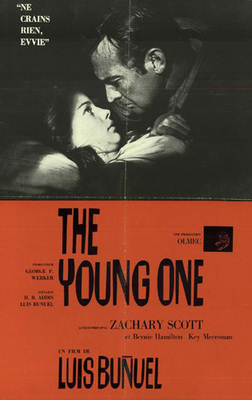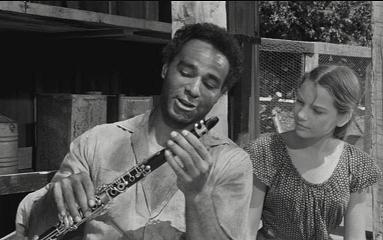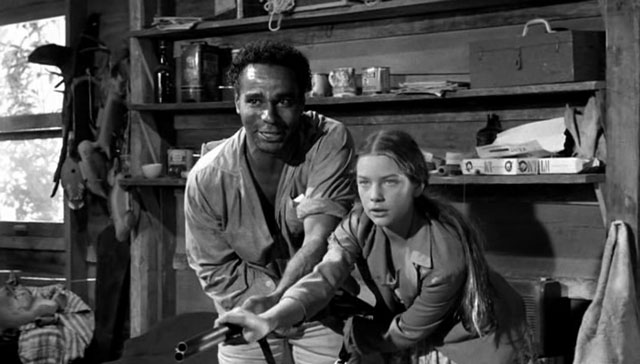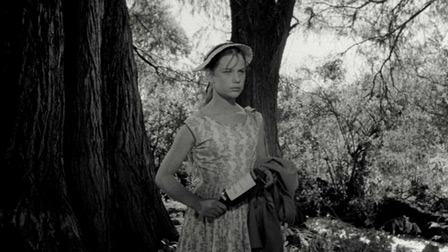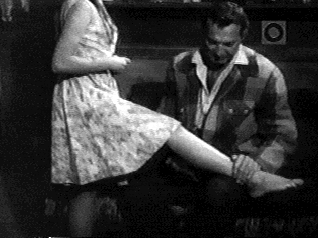From the Chicago Reader (October 8, 1993). — J.R.
THE YOUNG ONE
**** (Masterpiece)
Directed by Luis Buñuel
Written by “H.B. Addis” (Hugo Butler) and Buñuel
With Zachary Scott, Bernie Hamilton, Key Meersman, Crahan Denton, and Claudio Brook.
Let’s start with a dream scenario, a movie that might have been. What if Luis Buñuel had made a picture with an American producer, American screenwriter, and American actors during the height of the civil rights movement and set it in the rural south? What if the main character were a black jazz musician from the north fleeing from a lynching, falsely accused of raping a white woman? And, to make a still headier brew, what if Buñuel decided to work in the theme of Vladimir Nabokov’s Lolita, a recent best-seller — the deflowering of a young girl by a middle-aged man?
As a piece of exploitation, this hypothetical project fairly sizzles; yet in the hands of a poetic, corrosive, highly moral filmmaker like Buñuel, it could well transcend this category. Allowing for the strangeness that would naturally arise from a foreign director taking on such volatile American materials — indeed, a strangeness that might even enhance the freshness of his treatment — one could well anticipate the beauty and excitement such an encounter might produce.
The above scenario may sound far-fetched. But the fact of the matter is that what might have been actually exists, and has existed for the past 33 years. Luis Buñuel did all the things I’ve mentioned in 1960, but hardly anyone noticed — and most of those who did were far from pleased. Roger Angell accorded Buñuel’s film a dismissive paragraph in the New Yorker, the big Manhattan dailies were hostile, and, according to Buñuel, “A Harlem newspaper even wrote that I should be hung upside down from a lamppost on Fifth Avenue. . . . I made this film with love, but it never had a chance. American morality couldn’t accept it. It hardly did any better in Europe and even today, it’s hardly ever shown.”
Ever since I first saw The Young One, in Paris in the late 60s, I’ve never been able to accept the public consensus. The film has been all but written out of film history — accorded scant attention in most studies of Buñuel, and even less notice elsewhere. Very few people seem aware that it exists. At the same time, it’s impossible to imagine a time when such a movie could ever become fashionable. Apparently simple, it’s riddled with dark ironies and subtle ambiguities, and the surrealist high jinks that were Buñuel’s calling card at the very beginning and end of his career — most often figuring as signature interludes in his Mexican pictures — are nowhere in evidence.
Now Facets Multimedia is showing a new 35-millimeter print, recently released by Milestone Films, Saturday through Thursday, and you can judge for yourself. The Young One doesn’t have the immediate impact or legibility of Buñuel’s best-known works, and though it never fundamentally betrays Buñuel’s leftist convictions, it confounds so many workaday rules of political correctness — left and right, then and now — that no one could ever see it as any sort of tract. Buñuel has rightly called it one of his most personal projects, and it also happens to be one of the most pungent films about the American south ever made — though it was shot in its entirety in Mexico. One of his most sensual, sheerly physical works, it never qualifies as either pornography or sensationalism (though it was probably marketed as both), and its black comedy has a moral complexity typical of his finest work: the film refuses to label any of its five characters as a hero or villain. To quote Buñuel again, “This refusal of Manicheism was probably the major reason for the film’s commercial failure.”
It’s worth bearing in mind too that The Young One was made a full decade after Buñuel’s The Young and the Damned and only a year before Viridiana, the film that launched his highly successful “second” career as a mainly European director; it came at the tail end of a long period of low-budget Mexican pictures, most of which received very little international notice. In other words, it lacked a market in 1960, despite the racial and Lolita themes, because Buñuel still hadn’t become a “brand name” director, a recognized auteur. Yet at the moment, even with the Chicago Film Festival in full force, it’s hard to think of a better movie playing in town.
Over the strains of Leon Bibb singing “Sinner Man” — the only sound-track music we hear in the film — a black jazz clarinetist named Traver (Bernie Hamilton), fleeing for his life, arrives in a stolen boat at a game-preserve island off the Carolina coast. Miller (Zachary Scott), the game warden, kills a rabbit and brings it home to his shack, where he finds that his alcoholic handyman Pee-Wee has just died. Pee-Wee’s orphaned teenage granddaughter Evvie (Key Meersman) is putting on the dead man’s boots in the adjacent cabin and sniffling when Miller arrives, but he’s hardly affected. They cursorily bury Pee-Wee in the backyard — Evvie wants to bury his liquor bottle too until Miller sharply reprimands her for “wasting bad whiskey.”
In the morning, after Miller takes his boat into town, Evvie encounters Traver while tending to the beehives. Ravenous, he takes some honey from her but pays her $20 for one of Miller’s shotguns and some of his canned goods. They establish a wary friendship, and after Traver accidentally causes a leak in his boat, she supplies him with tools to repair it. When Miller returns that day and discovers that a black man has taken some of his things, he promptly chases after Traver, tries to kill him, and shoots several holes in his boat.
Several more tense confrontations and power shifts between Traver and Miller follow, complicated by the presence of Evvie; the object of Miller’s growing lust and Traver’s casual ally, she’s innocent of sexuality and racism alike. (And unlike Lolita’s, her innocence can’t be taken for flirtatiousness.) After Traver agrees to work temporarily as a handyman for Miller in return for board while he repairs the boat, he spends the night in Pee-Wee’s cabin, causing Evvie to move to Miller’s shack and thereby enabling Miller to consummate his lustful designs on her. Things are complicated still further by the arrival from town of a Protestant preacher (Claudio Brook) and Miller’s boatman Jackson (Crahan Denton), who discover at about the same time that Traver is fleeing from a rape charge and that Miller raped Evvie the night before.
The complex moral and practical trade-offs that ensue are too labyrinthine to recount in detail here, but it should be stressed that they’re at the heart of the movie. (In fact, the film basically consists of nothing but intricate transactions and exchanges — of goods, money, services, gifts, promises, favors, epithets, injuries, and loyalties.) In the final analysis, Buñuel refuses to condemn or exonerate anyone; to suggest only part of the film’s audacity, he shows that the smitten child abuser actually overcomes some of his racism once he too becomes a potential fugitive from justice, and one of his motives is wanting to win back Evvie’s respect. Traver — the only urban sophisticate in the movie, in contrast to the primitive rural feudalism of the other four — winds up sparing Jackson’s life in order to avoid another excuse for a lynching, but he’s hardly idealized: in one scene, trading war stories and racial insults with Miller, he’s made to seem almost as childish as his persecutor.
Jackson, who never ceases to be a monstrous bigot, isn’t judged unequivocally either; Buñuel clearly sees him as a crude, pathetic moron but also as the product of his conditioning, not simply as evil. By the same token, Buñuel appreciates but never patronizes Evvie’s “uncivilized” innocence, and we’re actually persuaded to wonder whether the preacher will have any more beneficial effect on her than Miller. When we briefly see her near the end, just before leaving for town, playing hopscotch in her hobbling high heels (a present from Miller), we’re led to ponder what price her “civilizing” at the hands of either man is likely to have. As for the preacher, he’s shown as principled, pious, and overtly nonracist, but that doesn’t prevent him from asking Evvie to flip Traver’s mattress before he’ll sleep on it himself.
A few words on the script, cinematography, and casting. The film is very loosely inspired by a 1957 Peter Matthiessen story, “Travelin Man,” that’s radically different in most particulars, apart from the swampy setting and its predatory inhabitants, which are rendered in detail. (Traver in the original is an escaped convict and arsonist who loves to fight — a much tougher customer, and neither a musician nor a northerner — and he winds up getting killed at the end by an unnamed white man corresponding roughly to Miller, whom he’s just clubbed; no other characters appear in the story.) The script is credited to “H.B. Addis” and Buñuel; the former is the pseudonym of Hugo Butler (1914-1968), a talented blacklisted screenwriter who moved to Mexico in 1951. The following year, under another blacklist pseudonym, he coscripted Buñuel’s only other film in English, the equally neglected Adventures of Robinson Crusoe, and his fascinating filmography also includes MGM prestige pictures of the late 30s and early 40s (The Adventures of Huckleberry Finn, Young Tom Edison, Lassie Come Home), Jean Renoir’s The Southerner, some of the best films of blacklisted directors John Berry (From This Day Forward, He Ran All the Way) and Joseph Losey (The Prowler, The Big Night, Eva), and Frank Tashlin’s first feature (The First Time).
The cinematographer is the great Gabriel Figueroa, who shot most of Buñuel’s best Mexican work (including The Young and the Damned, El, Nazarin, and The Exterminating Angel), and he can be credited for much of the film’s physical impact. Aside from Meersman, the actors are professionals: Zachary Scott, the best known, had already appeared in such Hollywood movies as The Southerner, Mildred Pierce, Ruthless, and Appointment in Honduras, while Bernie Hamilton is perhaps best known for Let No Man Write My Epitaph, The Devil at Four O’Clock, and One Potato, Two Potato. Claudio Brook, the preacher, was actually a Buñuel regular — the only non-American in the cast — and despite the awkwardness of his slight Spanish accent, his Reverend Fleetwood is a memorable and effective creation; his performing of Evvie’s baptism is priceless.
Approached superficially and ungenerously, The Young One might at first seem like a bad imitation of Tobacco Road; if one confuses its deceptive simplicity with simplemindedness, as some viewers have, it might even come across as camp. “How old are you?” Miller asks Evvie after noting that she’s starting to blossom physically. “I use t’know when Mom was alive, befo Gramps brot me out here,” Meersman replies in a delivery so flat as to make her seem not so much a bad actress as a nonactress. (Buñuel reported having so many difficulties directing her that he almost closed down the production, but in fact Meersman’s vibrantly unpolished presence turns out to be one of the movie’s clearest and sturdiest triumphs.) “You know,” Miller says, preparing to grasp her thigh, “they tell the age of a horse by his teeth, but with a woman or a hawg, it’s flesh and weight that counts.”
Many reviewers in 1960 alluded to Tennessee Williams, but apart from the southern setting, they couldn’t have been further from the mark. A much more probable literary source is William Faulkner, whom Buñuel on other occasions showed some interest in adapting. In fact Evvie registers at times as a younger, less idealized Lena Grove from Light in August –an innocent, semimindless character who knows precisely who she is and remains wholly secure in her identity as long as she remains on the island, unlike all the existentially unfocused and perpetually bargaining male “actors” surrounding her. (Meersman’s lack of guile, actorly and otherwise, also intermittently suggests a more glamorous version of Robert Bresson’s Mouchette as she goes about her daily chores.) Miller and Jackson’s casual meanness and the preacher’s square sincerity, both observed with ironic wit, also suggest Faulkner, but at the same time they’re quintessentially Buñuelian, revealing a humorously dispassionate view of human behavior and its contradictions.
The island itself — where all the action, apart from a brief early flashback, transpires — is a palpable, living presence with its swarming and chattering insects and varied plant and animal life, a character in its own right, closely identified with Evvie. Buñuel establishes this universe as elemental and predatory from the outset: a few minutes into the film Traver has eaten a live crab and Miller has shot a rabbit, and these men are far from the only predators; not long afterward Evvie knowingly steps on a scorpion, and we see a badger eating a chicken. But the natural world, like the characters, is never presented formulaically: Buñuel looks at everything with the patient, amused curiosity of an entomologist or anthropologist, though the society and world he examines are not fundamentally different from our own.

